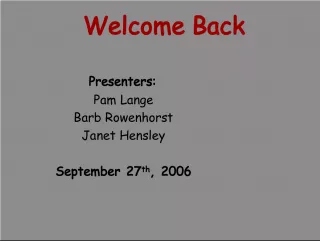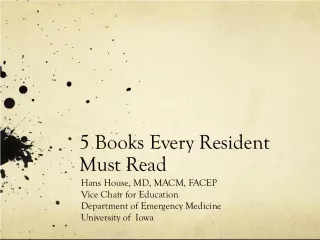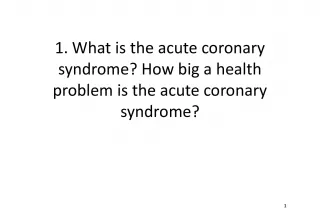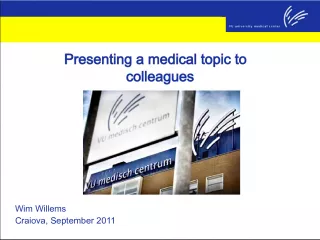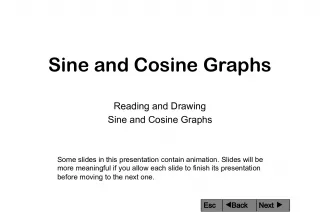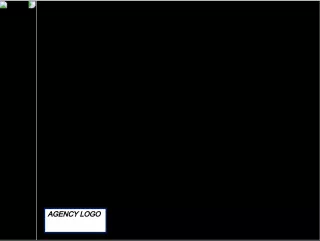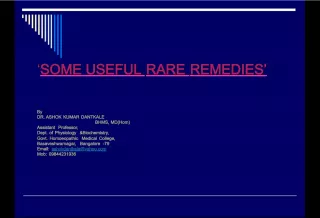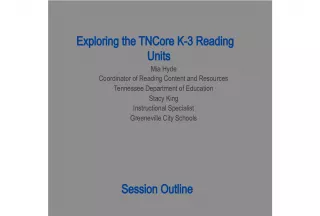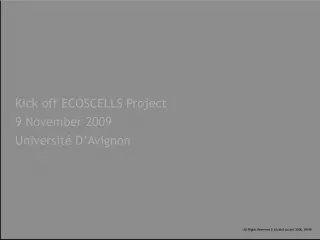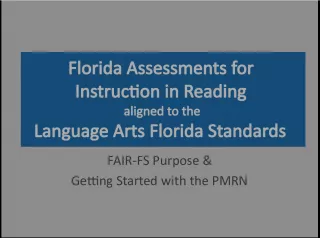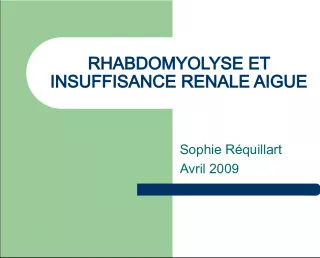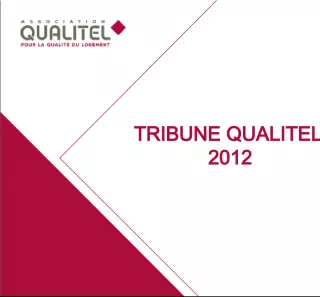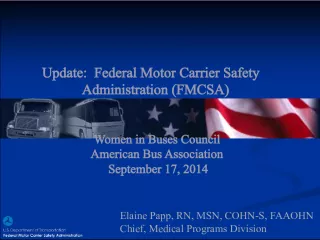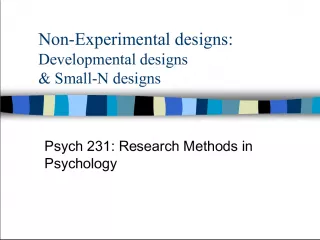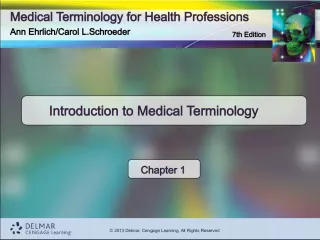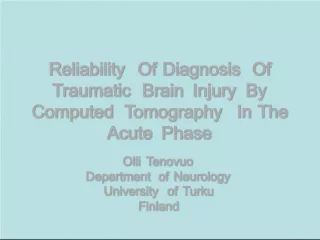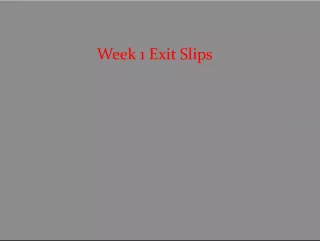Acute Abdominal Crises in Medical Student Small Group Discussions: Recommended Reading and Topics
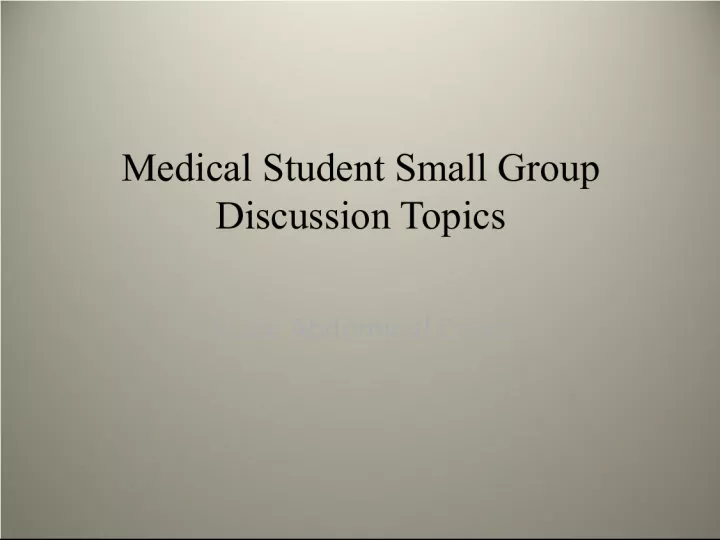

This article provides suggested reading from "Current Diagnosis and Treatment: Surgery" for medical students participating in small group discussions on acute abdominal crises. The topics covered include perforated peptic ulcers, gastric volvulus, appendicitis, small intestine obstruction, large intestine obstruction and diverticular disease, and pediatric intestinal disorders.
- Uploaded on | 0 Views
-
 janetlang
janetlang
About Acute Abdominal Crises in Medical Student Small Group Discussions: Recommended Reading and Topics
PowerPoint presentation about 'Acute Abdominal Crises in Medical Student Small Group Discussions: Recommended Reading and Topics'. This presentation describes the topic on This article provides suggested reading from "Current Diagnosis and Treatment: Surgery" for medical students participating in small group discussions on acute abdominal crises. The topics covered include perforated peptic ulcers, gastric volvulus, appendicitis, small intestine obstruction, large intestine obstruction and diverticular disease, and pediatric intestinal disorders.. The key topics included in this slideshow are medical student, small group discussions, acute abdominal crises, Current Diagnosis and Treatment, Surgery, perforated peptic ulcers, appendicitis, intestinal obstruction, diverticular disease, pediatric intestinal disorders,. Download this presentation absolutely free.
Presentation Transcript
1. Medical Student Small Group Discussion Topics Acute Abdominal Crises
2. Suggested Reading Current Diagnosis and Treatment: Surgery Chapter 21 The Acute Abdomen Chapter 23: Stomach and Duodenum Perforated Peptic Ulcer Gastric Volvulus Chapter 28: The Appendix Acute appendicitis Chapter 29: The Small Intestine Obstruction of the Small Intestine Acute Vascular Lesions of the Small Intestine & Mesentery Chapter 30: Large Intestine Diverticular Disease Obstruction of the Large Intestine Volvulus Chapter 43: Pediatric Surgery Intestinal obstruction in the newborn Disorders of intestinal rotation Intussusception Necrotizing Enterocolitis Current Diagnosis & Treatment: Surgery, Thirteenth Edition Edited by Gerard M. Doherty Copyright 2010 by The McGraw-Hill Companies, Inc.
3. Medical Student Small Group Discussion Topics What are the borders of, the blood supply to, and the organs contained within: What are the borders of, the blood supply to, and the organs contained within: The foregut? The foregut? The midgut? The midgut? The hindgut? The hindgut? Acute Abdominal Crises
4. Medical Student Small Group Discussion Topics Acute Abdominal Crises Describe the relevance of somatic pain fibers in the evaluation of abdominal pain in terms of: Describe the relevance of somatic pain fibers in the evaluation of abdominal pain in terms of: 1. Location of somatic pain fibers (Parietal vs visceral peritoneum)? 1. Location of somatic pain fibers (Parietal vs visceral peritoneum)? 2. Stimulants for somatic pain fiber activity? 2. Stimulants for somatic pain fiber activity? 3. Localization of pain when somatic fibers are stimulated? 3. Localization of pain when somatic fibers are stimulated?
5. Medical Student Small Group Discussion Topics Acute Abdominal Crises Describe the relevance of visceral pain fibers in the evaluation of abdominal pain in terms of: Describe the relevance of visceral pain fibers in the evaluation of abdominal pain in terms of: 1. Location of visceral pain fibers (Parietal vs visceral peritoneum)? 1. Location of visceral pain fibers (Parietal vs visceral peritoneum)? 2. Stimulants for visceral pain fiber activity? 2. Stimulants for visceral pain fiber activity? 3. Localization of pain when visceral fibers are stimulated? 3. Localization of pain when visceral fibers are stimulated?
6. Medical Student Small Group Discussion Topics Acute Abdominal Crises What are the important history of present illness questions to elicit from a patient complaining of abdominal pain? What are the important history of present illness questions to elicit from a patient complaining of abdominal pain?
7. Medical Student Small Group Discussion Topics Acute Abdominal Crises What are the important physical examination components you would want to assess in a patient complaining of abdominal pain? What are the important physical examination components you would want to assess in a patient complaining of abdominal pain?
8. Medical Student Small Group Discussion Topics A 70 year old man presents with left lower quadrant abdominal pain Acute Abdominal Crises Case #1
9. Medical Student Small Group Discussion Topics Acute Abdominal Crises Case #1 A 70 year old man presents with left lower quadrant abdominal pain The patients pain began about 24 hours ago becoming progressively worse over the next few hours. He describes the pain as sharp since it began. It is now very severe and has been, and remains, well localized in his left lower quadrant. The pain is continuous and worsened with movement. He reports subjective fevers although he has not taken his temperature. No nausea or vomiting. Some loose stools over the past few days. No recent or past history of significant constipation. He is not particularly hungry. He has had no recent weight loss nor has he noted blood in his stool or any change in the caliber of his stools. Last bowel movement was earlier this morning and he has been having flatus. The patients pain began about 24 hours ago becoming progressively worse over the next few hours. He describes the pain as sharp since it began. It is now very severe and has been, and remains, well localized in his left lower quadrant. The pain is continuous and worsened with movement. He reports subjective fevers although he has not taken his temperature. No nausea or vomiting. Some loose stools over the past few days. No recent or past history of significant constipation. He is not particularly hungry. He has had no recent weight loss nor has he noted blood in his stool or any change in the caliber of his stools. Last bowel movement was earlier this morning and he has been having flatus.
10. Medical Student Small Group Discussion Topics Acute Abdominal Crises Case #1 A 70 year old man presents with left lower quadrant abdominal pain How do you interpret the significance of the patients reported history? Consider the role of visceral and somatic pain fibers in the patients complaints and the possible pathophysiologic causes for the reported findings. How do you interpret the significance of the patients reported history? Consider the role of visceral and somatic pain fibers in the patients complaints and the possible pathophysiologic causes for the reported findings.
11. Medical Student Small Group Discussion Topics Acute Abdominal Crises Case #1 A 70 year old man presents with left lower quadrant abdominal pain On examination, the patient is awake alert and oriented. He is lying still on the examining table. He has a temperature of 38.8 C (101.8 F). Heart is regular in rate and rhythm without murmur, rub, or gallop. On inspection, his abdomen is without distension, bruising, or previous incisions. Bowel sounds are hypoactive. Percussion of his abdomen reveals neither tympani nor dullness. However, the patient complains that percussion in the left lower quadrant is painful. His abdomen is tender to palpation in the left lower quadrant with significant rebound tenderness referred to the left lower quadrant. No abdominal masses are noted. There is some involuntary guarding in the left lower quadrant. He has no hernias on examination. On examination, the patient is awake alert and oriented. He is lying still on the examining table. He has a temperature of 38.8 C (101.8 F). Heart is regular in rate and rhythm without murmur, rub, or gallop. On inspection, his abdomen is without distension, bruising, or previous incisions. Bowel sounds are hypoactive. Percussion of his abdomen reveals neither tympani nor dullness. However, the patient complains that percussion in the left lower quadrant is painful. His abdomen is tender to palpation in the left lower quadrant with significant rebound tenderness referred to the left lower quadrant. No abdominal masses are noted. There is some involuntary guarding in the left lower quadrant. He has no hernias on examination.
12. Medical Student Small Group Discussion Topics Acute Abdominal Crises Case #1 A 70 year old man presents with left lower quadrant abdominal pain How do you interpret the significance of the patients physical examination findings? Consider the role of visceral and somatic pain fibers in the patients findings, and the possible pathophysiologic causes for the reported findings. How do you interpret the significance of the patients physical examination findings? Consider the role of visceral and somatic pain fibers in the patients findings, and the possible pathophysiologic causes for the reported findings.
13. Medical Student Small Group Discussion Topics Acute Abdominal Crises Case #1 A 70 year old man presents with left lower quadrant abdominal pain Based on your history and physical examination alone, what do you believe is the pathophysiology of the patients acute condition? Based on your history and physical examination alone, what do you believe is the pathophysiology of the patients acute condition?
14. Medical Student Small Group Discussion Topics Acute Abdominal Crises Case #1 A 70 year old man presents with left lower quadrant abdominal pain What is your differential diagnosis and which is most likely taking the patients history and physical examination findings into account? What is your differential diagnosis and which is most likely taking the patients history and physical examination findings into account?
15. Medical Student Small Group Discussion Topics A 55-year-old man with a complaint of severe, progressing abdominal pain. Acute Abdominal Crises Case #2
16. Medical Student Small Group Discussion Topics History and Physical Findings The patient, who is in general good health, arrives by ambulance with a complaint of severe, unrelenting abdominal pain which came on very suddenly three hours earlier. His blood pressure is 90/50, pulse 130, temperature 38 and respirations 16. His physical examination reveals abdominal distention, no bowel sounds, and involuntary guarding throughout, (a board-like abdomen). Acute Abdominal Crises Case #2 A 55-year-old man with a complaint of severe, progressing abdominal pain.
17. Medical Student Small Group Discussion Topics Acute Abdominal Crises Case #2 An abdominal series is ordered with the following being one of those films.
18. Medical Student Small Group Discussion Topics What is your differential diagnosis? Acute Abdominal Crises Case #2 A 55-year-old man with a complaint of severe, progressing abdominal pain.
19. Medical Student Small Group Discussion Topics What is your next diagnostic step in managing this patient? Acute Abdominal Crises Case #2 A 55-year-old man with a complaint of severe, progressing abdominal pain.
20. Medical Student Small Group Discussion Topics Is there anything you would do prior to taking this patient to the operating room? Acute Abdominal Crises Case #2 A 55-year-old man with a complaint of severe, progressing abdominal pain.
21. Medical Student Small Group Discussion Topics A 20-year-old woman comes to the emergency room with a complaint of right lower quadrant pain of 12 hours duration. Acute Abdominal Crises Case #3
22. Medical Student Small Group Discussion Topics History and Physical Findings History and Physical Findings The patient comes to your office with a complaint of right lower quadrant pain of 12 hours duration. She is sexually active and has had an episode of PID one year ago. The present pain is more severe and more on the right. Her last period was two weeks ago and was on time. She is anorectic and has had some burning on urination. She has a blood pressure of 110/60, pulse 100, temperature 38.5C (101.3F) and respirations 12. Physical examination of the abdomen is consistent with peritonitis in the right lower quadrant. Pelvic examination reveals minimal cervical tenderness with a tender fullness in the right adnexa. The patient comes to your office with a complaint of right lower quadrant pain of 12 hours duration. She is sexually active and has had an episode of PID one year ago. The present pain is more severe and more on the right. Her last period was two weeks ago and was on time. She is anorectic and has had some burning on urination. She has a blood pressure of 110/60, pulse 100, temperature 38.5C (101.3F) and respirations 12. Physical examination of the abdomen is consistent with peritonitis in the right lower quadrant. Pelvic examination reveals minimal cervical tenderness with a tender fullness in the right adnexa. Acute Abdominal Crises Case #3
23. Medical Student Small Group Discussion Topics What is your differential diagnosis? What is your differential diagnosis? Acute Abdominal Crises Case #3 A 20-year-old woman comes to the emergency room with a complaint of right lower quadrant pain of 12 hours duration.
24. Medical Student Small Group Discussion Topics How would you make the diagnosis? How would you make the diagnosis? Acute Abdominal Crises Case #3 A 20-year-old woman comes to the emergency room with a complaint of right lower quadrant pain of 12 hours duration.
25. Medical Student Small Group Discussion Topics What if the patient was male? Would this change your management? What if the patient was male? Would this change your management? Acute Abdominal Crises Case #3
26. Medical Student Small Group Discussion Topics A 44-year-old man is admitted to the hospital because of crampy abdominal pain and bilious vomiting that has lasted for three days. A 44-year-old man is admitted to the hospital because of crampy abdominal pain and bilious vomiting that has lasted for three days. Acute Abdominal Crises Case #4
27. Medical Student Small Group Discussion Topics History and Physical Findings History and Physical Findings The patient has not had a bowel movement or flatus for two days. Ten years ago he had an appendectomy for a perforated appendicitis, with no postoperative complications. Physical examination reveals a pulse of 100, blood pressure 110/60, temperature 35.5C. His abdomen is distended with hyperactive bowel sounds and tympany throughout. There is no abdominal tenderness to palpation. The patient has not had a bowel movement or flatus for two days. Ten years ago he had an appendectomy for a perforated appendicitis, with no postoperative complications. Physical examination reveals a pulse of 100, blood pressure 110/60, temperature 35.5C. His abdomen is distended with hyperactive bowel sounds and tympany throughout. There is no abdominal tenderness to palpation. Acute Abdominal Crises Case #4 A 44-year-old man is admitted to the hospital because of crampy abdominal pain and bilious vomiting that has lasted for three days.
28. Medical Student Small Group Discussion Topics Which diagnostic laboratory tests are indicated? Which diagnostic laboratory tests are indicated? Acute Abdominal Crises Case #4 A 44-year-old man is admitted to the hospital because of crampy abdominal pain and bilious vomiting that has lasted for three days.
29. Medical Student Small Group Discussion Topics Which imagining study should be initially obtained to confirm your clinical diagnosis? Which imagining study should be initially obtained to confirm your clinical diagnosis? Acute Abdominal Crises Case #4 A 44-year-old man is admitted to the hospital because of crampy abdominal pain and bilious vomiting that has lasted for three days.
30. Medical Student Small Group Discussion Topics What is the most likely diagnosis and what is the likely etiology for this patients current condition? What is the most likely diagnosis and what is the likely etiology for this patients current condition? Acute Abdominal Crises Case #4 A 44-year-old man is admitted to the hospital because of crampy abdominal pain and bilious vomiting that has lasted for three days.
31. Medical Student Small Group Discussion Topics What would be the most likely etiologies if the patient had never had any previous abdominal surgery? What would be the most likely etiologies if the patient had never had any previous abdominal surgery? Acute Abdominal Crises Case #4 A 44-year-old man is admitted to the hospital because of crampy abdominal pain and bilious vomiting that has lasted for three days.
32. Medical Student Small Group Discussion Topics What is your initial management plan for this patient? What is your initial management plan for this patient? Acute Abdominal Crises Case #4 A 44-year-old man is admitted to the hospital because of crampy abdominal pain and bilious vomiting that has lasted for three days.
33. Medical Student Small Group Discussion Topics Which findings, if present, would be ominous indications that the patient needed urgent operative treatment? Which findings, if present, would be ominous indications that the patient needed urgent operative treatment? Acute Abdominal Crises Case #4 A 44-year-old man is admitted to the hospital because of crampy abdominal pain and bilious vomiting that has lasted for three days.
34. Medical Student Small Group Discussion Topics A 95-year-old man is sent to the emergency room from a nursing home with complaints of abdominal pain and distension. A 95-year-old man is sent to the emergency room from a nursing home with complaints of abdominal pain and distension. Acute Abdominal Crises Case #5
35. Medical Student Small Group Discussion Topics History and Physical Findings History and Physical Findings It is unclear, but staff at the nursing home think it has been about four days since he had a bowel movement. On examination, the patient has an expressive aphasia and a right hemiparesis from a previous stroke. His vital signs are pulse 90, blood pressure 120/80, and he is afebrile. There is no abdominal tenderness. Rectal exam reveals large quantities of soft, brown, guaiac negative stool. KUP and upright reveal markedly dilated colon consistent with obstruction. It is unclear, but staff at the nursing home think it has been about four days since he had a bowel movement. On examination, the patient has an expressive aphasia and a right hemiparesis from a previous stroke. His vital signs are pulse 90, blood pressure 120/80, and he is afebrile. There is no abdominal tenderness. Rectal exam reveals large quantities of soft, brown, guaiac negative stool. KUP and upright reveal markedly dilated colon consistent with obstruction. Acute Abdominal Crises Case #5
36. Medical Student Small Group Discussion Topics What is the differential diagnosis of a large bowel obstruction? What is the differential diagnosis of a large bowel obstruction? Acute Abdominal Crises Case #5 A 95-year-old man is sent to the emergency room from a nursing home with complaints of abdominal pain and distension.
37. Medical Student Small Group Discussion Topics What test(s) would you employ to determine a specific diagnosis? What test(s) would you employ to determine a specific diagnosis? Acute Abdominal Crises Case #5 A 95-year-old man is sent to the emergency room from a nursing home with complaints of abdominal pain and distension.
38. Medical Student Small Group Discussion Topics Outline your treatment plan for a patient with volvulus. Outline your treatment plan for a patient with volvulus. Acute Abdominal Crises Case #5 A 95-year-old man is sent to the emergency room from a nursing home with complaints of abdominal pain and distension.
39. Medical Student Small Group Discussion Topics Where can a volvulus develop and what are the typical patient characteristics? Where can a volvulus develop and what are the typical patient characteristics? Acute Abdominal Crises Case #5 A 95-year-old man is sent to the emergency room from a nursing home with complaints of abdominal pain and distension.
40. Medical Student Small Group Discussion Topics How would this differ from your treatment of a patient with a colon cancer or impaction? How would this differ from your treatment of a patient with a colon cancer or impaction? Acute Abdominal Crises Case #5
41. Medical Student Small Group Discussion Topics What are the potential complications of a patient with a large bowel obstruction if left untreated? What are the potential complications of a patient with a large bowel obstruction if left untreated? Acute Abdominal Crises Case #5
